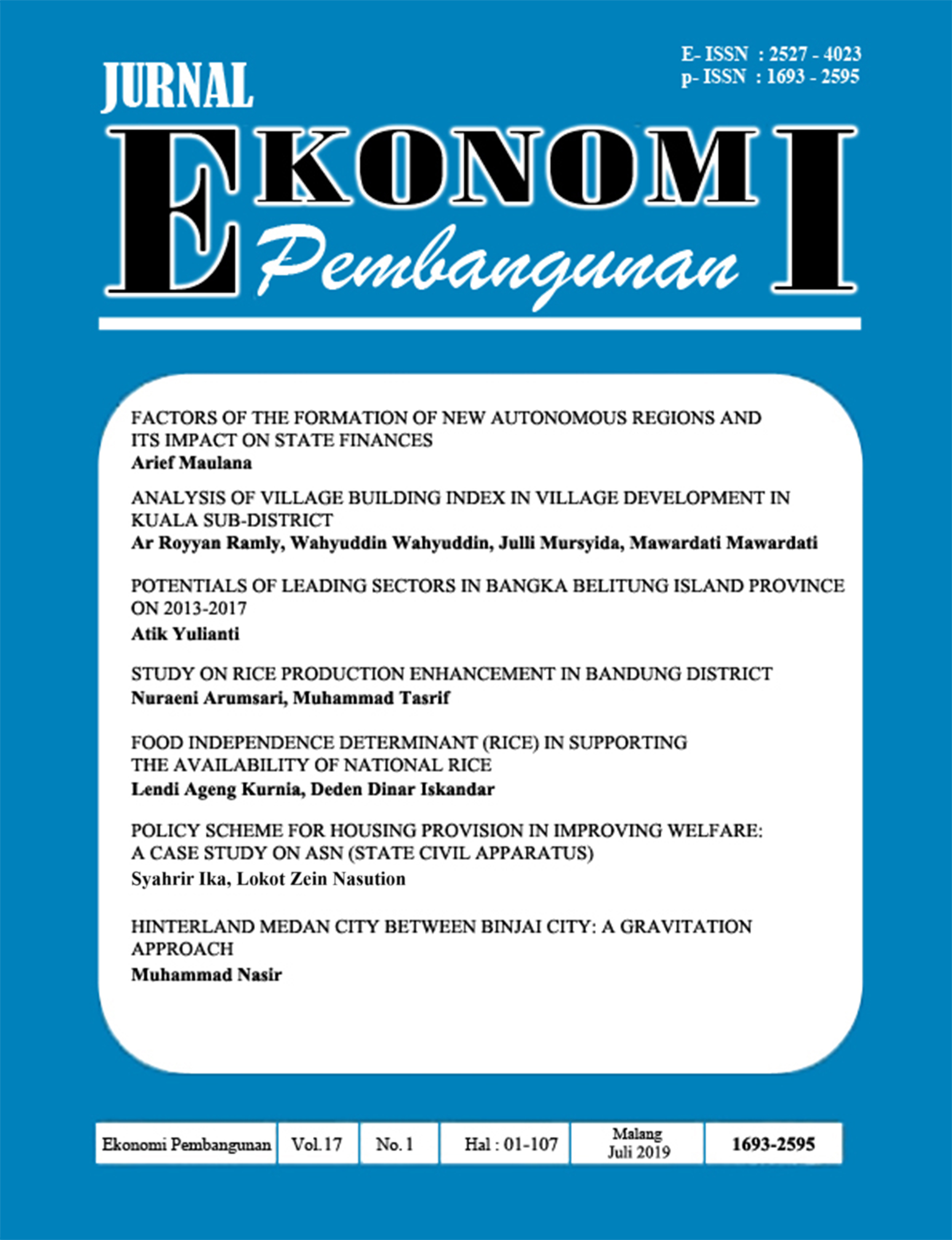HINTERLAND MEDAN CITY BETWEEN BINJAI CITY: A GRAVITATION APPROACH
DOI:
https://doi.org/10.22219/jep.v17i1.8745Keywords:
Gravity model, economy of medan city, economy of Binjai cityAbstract
Regional economy explains that there is an urban hierarchical relationship, cities that have higher hierarchy will serve cities that are below it as well as cities that are in hierarchy under supplying cities that are in the hierarchy above them, so there is a gravitational relationship between the two. This study aims to determine the gravitational relationship of Medan city to the hinterland of the city of Binjai. Furthermore, this study also wants to explain its influence on economic growth in both cities. This study uses time series data from 1990-2016, taken from North Sumatera BPS test equipment and analysis tools used are descriptive statistics, gravity models, unit root test, co-integration test, optimal lag, VECM, granger causality test, impulse response function and variance decomposition. The results showed that the city of Medan has a gravity style greater than the gravitational style of the city of Binjai. This is because the city of Medan has a larger area, population, income per capita compared to the city of Binjai. The VECM estimation results show that the gravitational variable in the city of Binjai in lag -1 and lag-2 has a positive and significant effect on the economy of Medan city with a confidence level of 95%. Then the economic variable of the city of Binjai itself in lag-1, the population of the city of Medan in lag-2 and the gravity of the city of Medan in lag-2 had a positive and significant effect on the economy of Binjai city with a confidence level of 95%. While the variable population of Binjai city in lag -1 and residents of the city of Medan in lag -1 negatively affected the economy of Binjai city with a confidence level of 95%.Downloads
References
Alfonso W. 1999. Ketidak Seimbangan Kota dan Daerah. Ekonomi Keuangan Indonesia, Vol XXXVII, No 3.
Bambang Suhardi. 2004. Model Potensial Gravitasi Hansen Untuk Menentukan Pertumbuhan Populasi Daerah, Performa 2004, Vol.3 no.1: 28-32.
Dini Yuniarti. 2007. Analisis Determinan Perdagangan Bilateral Indonesia Pendekatan Gravity Model, Jurnal Ekonomi Pembangunan, Vol.12 No.2: 99-109
Fitzsimon, Emla, Vincent,Hoga, J Peter Neary. 1991. Explaining The Volume of North-South Trade in Ireland: A Gravity Model. The Economic and Social Review, Vol 30, No 4.
Kalbasi Hasan. 2001. The Gravity Model and Global Trade Flows. www.ecomod.net/Conference/ecomod 2001/Paper-w/Kalbasi.pdf.
Nasir, M. 2017. Analisis Pengaruh Sektor Ekonomi Memiliki Nilai LQ>1 Terhadap Peningkatan Kesejahteraan Masyarakat Kota di Sumatra Utara. Jurnal Ekonomi Kawan UMSU.
Ridwan, Ridwan. 2009. Dampak Integrasi Ekonomi Terhadap Investasi di Kawasan ASEAN: Analisis Model Gravitasi. Jurnal Organisasi dan Manajemen, Vol.5, No.2.
Shantika, Martha, Evi, Jurianti. 2016. Analisis Pertumbuhan Ekonomi Kota Pontianak dengan Metode Location Quotient, Shief Share dan Gravitasi. Bimaster, Vol. 5 No.01.
Syafrizal. 2012. Ekonomi Wilayah dan Perkotaan. Jakarta: Raja Grafindo Persada.
Tarigan, Robinson. 2016. Perencanaan Pembangunan Wilayah. Jakarta: Bumi Aksara.
Wiyadi dan Trisnawati, Rina. 2002. Analisis Potensi Daerah Untuk Mengembangkan Wilayah Di Eks-Keresiden Surakarta Menggunakan Teori Pusat Pertumbuhan. Jurnal Riset Akuntansi dan Keuangan Indonesia.
Downloads
Published
Issue
Section
License
Authors who publish with Jurnal Ekonomi Pembangunan (JEP) agree to the following terms:
- For all articles published in Jurnal Ekonomi Pembangunan (JEP), copyright is retained by the authors. Authors permit the publisher to announce the work with conditions. When the manuscript is accepted for publication, the authors agree to the publishing right's automatic transfer to the publisher.
- Authors retain copyright and grant the journal right of first publication with the work simultaneously licensed under a Creative Commons Attribution-NonCommercial-ShareAlike 4.0 International License that allows others to share the work with an acknowledgment of the work's authorship and initial publication in this journal.
- Authors can enter into separate, additional contractual arrangements for the non-exclusive distribution of the journal's published version of the work (e.g., post it to an institutional repository or publish it in a book), with an acknowledgment of its initial publication in this journal.
- Authors are permitted and encouraged to post their work online (e.g., in institutional repositories or on their website) before and during the submission process, as it can lead to productive exchanges and earlier and greater citation of published work (See The Effect of Open Access).

This work is licensed under a Creative Commons Attribution-NonCommercial-ShareAlike 4.0 International License.






















